Ryan Gauld is one of those cases of players that show great promise at very young ages and, because of that, a big fuss is created around them. In some cases like this, with the media raising the fans’ and everyone else’s expectations, the players might feel added pressure and that might have a negative impact on their performances. In the summer of the 2014/2015 season, Ryan Gauld made a move from Dundee United to Sporting CP for around 2.75 million euros and this transfer resulted in many headlines. Nicknamed “mini Messi” Ryan Gauld started his journey at Sporting CP with extra expectation because of this comparison with the Barcelona and La Liga star. Playing in both the second team and the U19 but with everyone expecting and waiting for his debut in the first team in a year that Sporting were playing Champions League football. The adaptation for the young Scottish midfielder was rough and Ryan Gauld never quite reached the level expected from him in Sporting’s youth teams; he was able to produce quality performances but nothing of the expected magnitude.
Having only played 321 minutes for Sporting’s first team, Ryan Gauld was loaned out to various clubs such as Desportivo Das Aves and Hiberninan FC back in his homeland Scotland. Despite getting more playing time in these clubs, Gauld’s first season at a good level came in the 2019/2020 season playing for SC Farense in the Portuguese second division. The Scot’s performances brought success to the team and Farense were promoted to the Portuguese first division many years after their last spell in the top flight. Ryan Gauld was nominated as the best player in the Portuguese second division and now, aged 24, the attacking midfielder still has the time to reach his best level. Proof of that are the 8 goals and 3 assists last season in the league for Farense.
In this article we are going to analyse Ryan Gauld’s evolution with particular emphasis on his last season for Farense, a statistical and tactical analysis which will allow us to build a complete scout report and hopefully answer the question once and for all: Is Ryan Gauld made for top flight football ? Will this be his breakthrough season in Liga NOS ?
Player Profile
Ryan Gauld is a 24 year-old attacking midfielder that can also act as a winger, he is a small yet agile player, which makes him perfect to operate in tight spaces. To pair with his agile and fast physique Ryan Gauld has very good technical ability with the ball at his feet, he is able to dribble, pass, shoot or cross always with quality and that is due to his amazing left foot. Apart from being technically gifted Ryan Gauld shows good spatial awareness and vision, those characteristics allow him not only to find space for his teammates, but also for himself, and that shows in the fact that he usually contributes both with goals and assists/chances created for his team.
With a very general profile carved out for Ryan Gauld, it is time to get to more in depth aspects of his game in order to understand his style of play, strengths, and weaknesses a little bit better. Having that in mind, we will now take a look at Ryan Gauld’s heat map, this map shows the areas of the pitch where the player has the most actions and, therefore, where he operates the most.
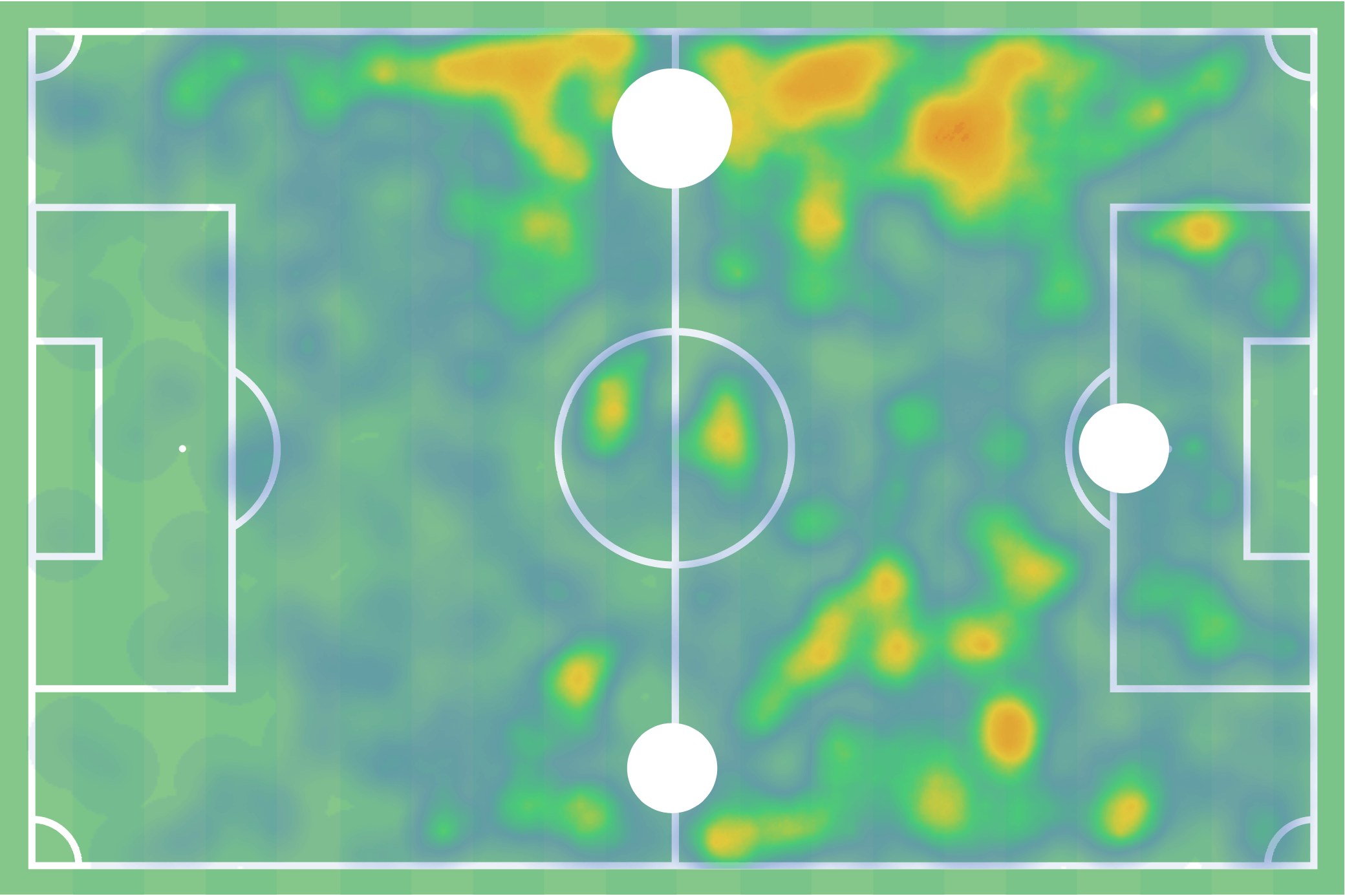
Looking at the heat map we can clearly see Gauld’s big presence in the final third particularly in the wide and half spaces, at the same time, there is also some involvement in more central areas by the Scot and that is good evidence of his versatility as a player. Playing as a winger, Ryan Gauld has a natural tendency to drift inside especially if on the right side of the pitch; he is not a traditional winger with a vertical style of play, instead, he is more of a wide playmaker leaving width to be exploited by the full-back on his side. His passing quality and technique as well as his vision are one of the reasons why he was used as a winger at times, as from the wide areas Gauld can come inside to try and create danger through combinations or, if the chance is there, he can play through balls/crosses for teammates making runs in behind.
To support what was said while at the same time bringing a more factual side to this article we are going to look at Ryan Gauld’s statistical profile from last season. As was already said, Gauld had a fantastic season that earned him the prize of the best player in the Portuguese 2nd division, and the data will help us see in a measurable way exactly what was the Scottish international’s contribution as well as to start to learn some aspects related to his style of play. To do this, we used data from Wyscout on all attacking midfielders, second strikers and wingers from the Portuguese 2nd division. In the end our data pool was composed of 153 players from the Portuguese 2nd division who play in the same positions as Ryan Gauld including him. Calculating percentile ranks for key metrics allowed us to make a comparison between Gauld and all the players in the mentioned positions, giving us a good view of the “reasons” behind that best player of the season award.
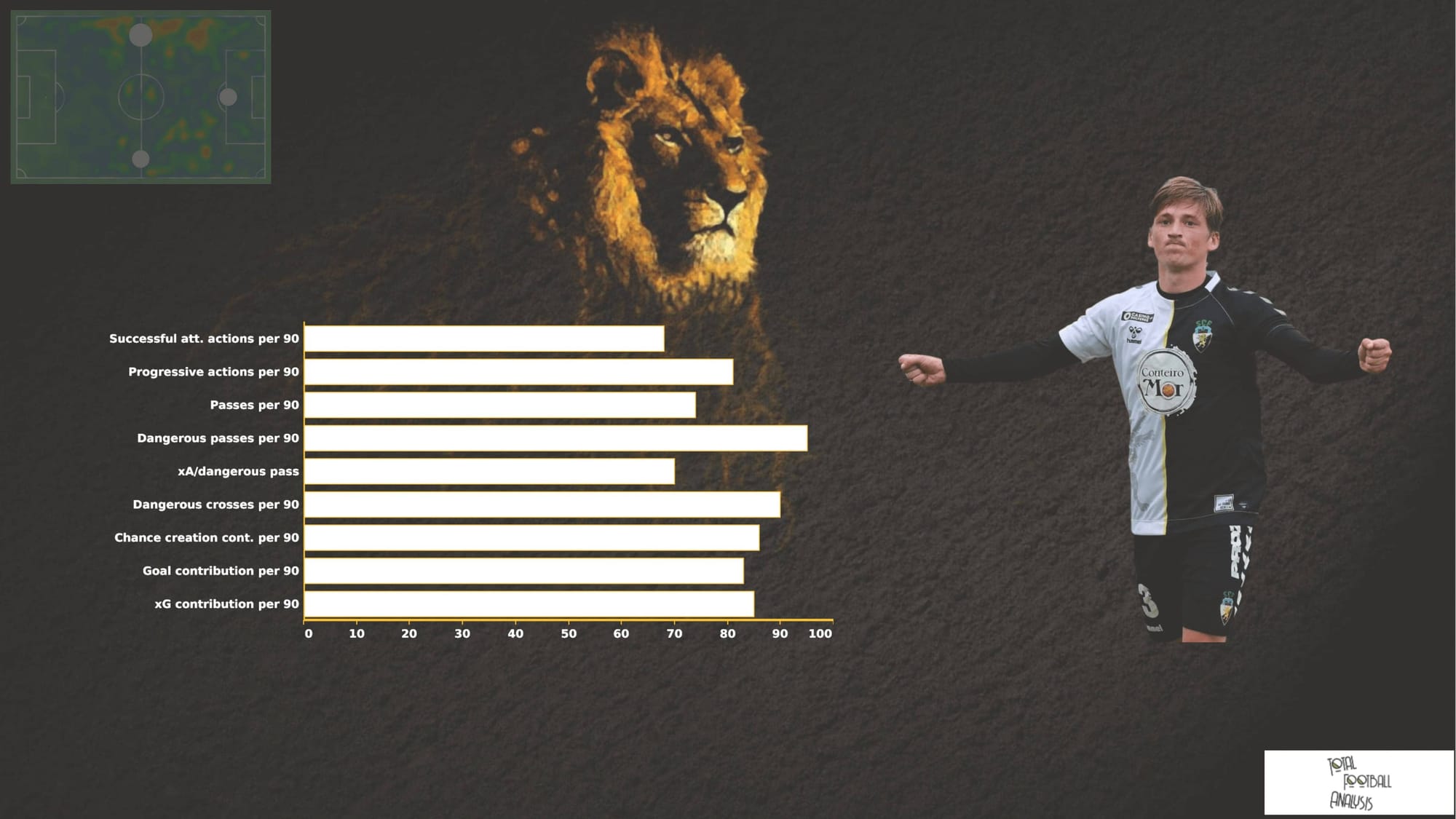
Looking at the bar chart and the metrics in it one can easily understand why the choice fell on these specific metrics. Ryan Gauld is in essence a creative player with a great ability to deliver the ball to his teammates in good positions, as such, offensive and chance creation related metrics are the ones where we can really measure his output seeing that is in fact his role in a team. Starting with some context, the metrics “Chance creation contribution per 90”, “Dangerous passes per 90”, “Dangerous crosses per 90” and “xA/dangerous pass” need some explaining. All these metric were obtained via other standard metrics, dangerous passes per 90 is a result of adding passes to the final third per 90, passes to the penalty area per 90 and deep completions per 90. Dangerous crosses per 90 is obtained by adding crosses to the goalie box per 90 and deep completed crosses, chances creation contribution is the sum of assists per 90, second assists per 90, third assists per 90 and key passes per 90. Finally, xA/dangerous pass is the xA value for each dangerous pass, in other words, the probability of that pass resulting in an assist and its obtained by dividing xA per 90 by dangerous passes per 90.
An analysis of the chart shows us how Ryan Gauld displays high percentiles in most metrics, in terms of passing, he displays a high but not huge volume and stands around the 75th percentile in passes per 90, however, stats show that he is very capable of creating danger with the passes he attempts. Gauld sits in the 95th percentile when it comes to dangerous passes per 90 which means he is close to being the best of the players compared, this translates into 10.84 dangerous passes per 90, while also rising to the 90th percentile in terms of dangerous crosses per 90 with 1.3. These stats indicate just the same that was said before, Ryan Gauld is able to create chances either by delivering crosses or passes into dangerous areas and that is why he can play as an attacking midfielder, as a winger or even as a second striker in a role with a big focus on chance creation. But Gauld is able to finish chances himself, as we’ll see further forward, he is able to get into good shooting positions and score from them, so to add to his high score in terms of chance creation contribution he also his goal contribution and xG percentiles above 80 proving just that. Last but not least his 6.78 progressive actions per 90 also rank him above the 80th percentile which hints at Gauld’s good vision and passing that allow him to pick out line breaking and through passes for his teammates.
We’ve seen the numbers, Ryan Gauld has certainly had a very good season for Farense scoring eight goals in the league and assisting three while also creating various chances for his team and putting out great performances. The Scot has certainly evolved since his Sporting CP days and despite is career being marked by loans and lack of game time in the first-team of the Lisbon club, his permanent move to Farense brought new life to his form. In order to better understand Gauld’s development and see what type of player he is now, we’ll take a look at key aspects of his style of play through in-game actions.
Ball progressing and passing
Ryan Gauld’s ball progressing abilities were already mentioned when analysing the bar chart because of his high percentile rank in progressive actions per 90, in this section, we are going to analyse in-game examples of how Ryan Gauld is able to play progressively both through passing and carrying the ball himself.
Despite the position he is playing in, Ryan Gauld usually operates in the final third either in the half or wide spaces when playing as a winger or in more central spaces when playing as an attacking midfielder. This means that although his starting position variess with the position, the type of spaces Ryan Gauld looks for are usually the same. To get the ball to these advanced spaces however, sometimes Gauld drops deeper into the midfield area to help his team progress the ball up the pitch. He has the quality to receive the ball on the half-turn and “face the game” which allows him to spot passing lanes better and play progressive passes breaking the opponent’s pressing lines.
In the sequence of images below we can see Ryan Gauld dropping deep in the midfield and doing precisely what was described. He receives the ball on the half-turn and then plays a through pass for his team’s full-back who is making a run on the left flank.

This image is only an example of course and to give us a more global view of Ryan Gauld’s progressive actions we are going to take a look at his ball progression map from Wyscout. This map shows the starting and ending points of Ryan Gauld’s progressive actions and also classifies them by their nature.
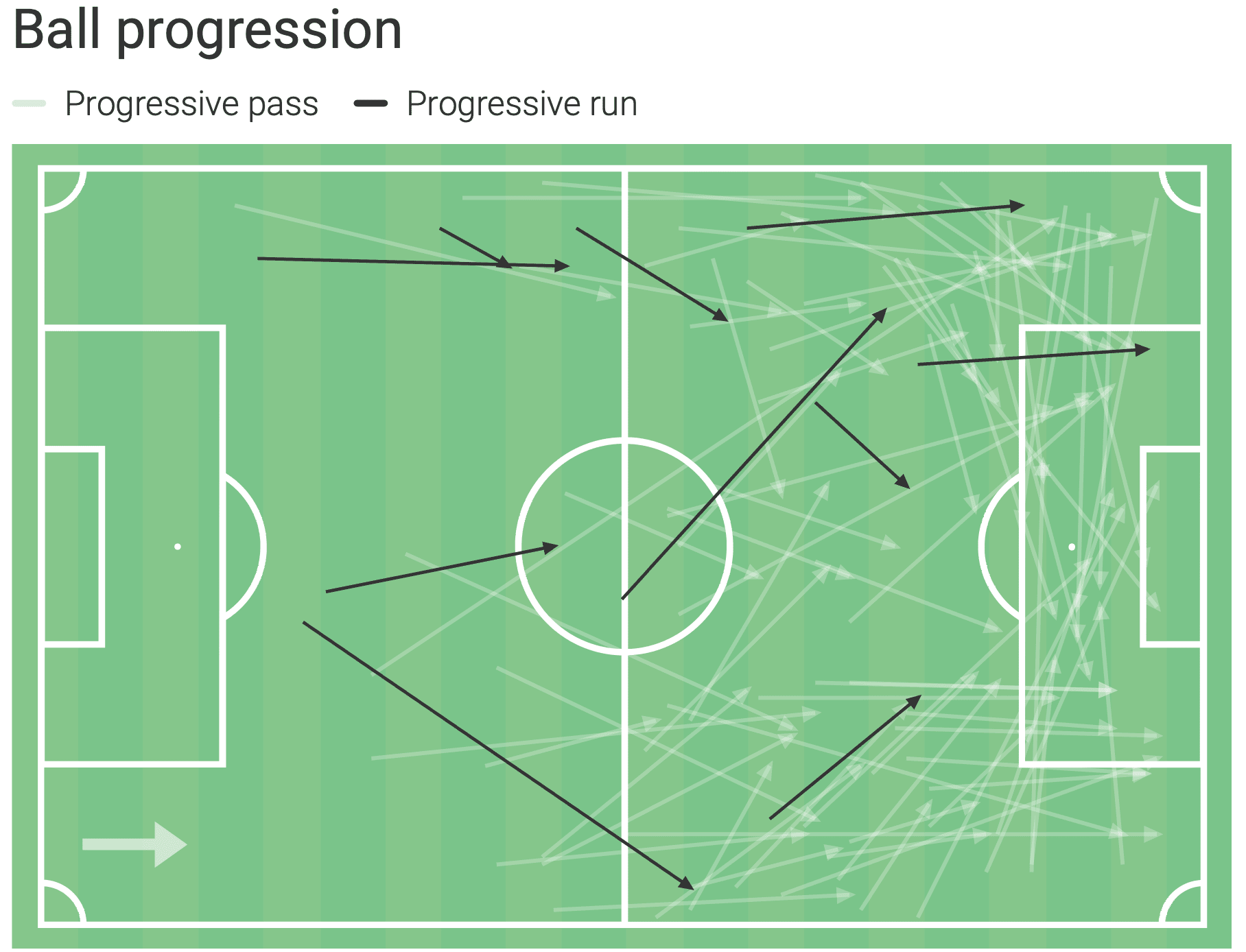
Analysing the map allows us to notice some clear patterns consistent with aspects already mentioned previously. Most of Ryan Gauld’s progressive actions come from the final third, however, there are some passes and carries that start in deeper positions representing Gauld’s movement to receive the ball and progress it up the pitch just like shown before the map. We can also see a pattern related to the starting point of the actions, most of them start either in the half or wide spaces and they mostly end in dangerous areas in and around the box. This really demonstrates how Ryan Gauld is very good at getting the ball through dangerous areas and why he scored so high in terms of dangerous passes in our statistical analysis.
Chance creation and creativity
Ryan Gauld’s creative nature as a player was already mentioned earlier in this article, nevertheless, it is always worth reinforcing the point that the Scot is very much a chance creator. Because of this Gauld always tries to receive the ball in the final third facing the opposition’s defensive line, and often succeeds, giving him a full view of his teammates and opponents and the movements everyone is making. Once in this position, Gauld makes use of his technique to produce either a cross or a final pass to get a teammate in a dangerous position.
In this next sequence of images we have a very good example of how Ryan Gauld is a creative player when in the final third and facing the opposition’s defensive line. He receives the ball and then dribbles inside from the left wide space passing in between two defenders, after that, he has the vision and passing ability to play a through pass for his teammate leaving him in a 1vs1 situation against the goalkeeper. Even though he wasn’t able to receive the ball in the desired area immediately, Ryan Gauld looked for space in that area so he could be in a central position and facing the game and that shows how he is creative and aware of the spaces he should look for.
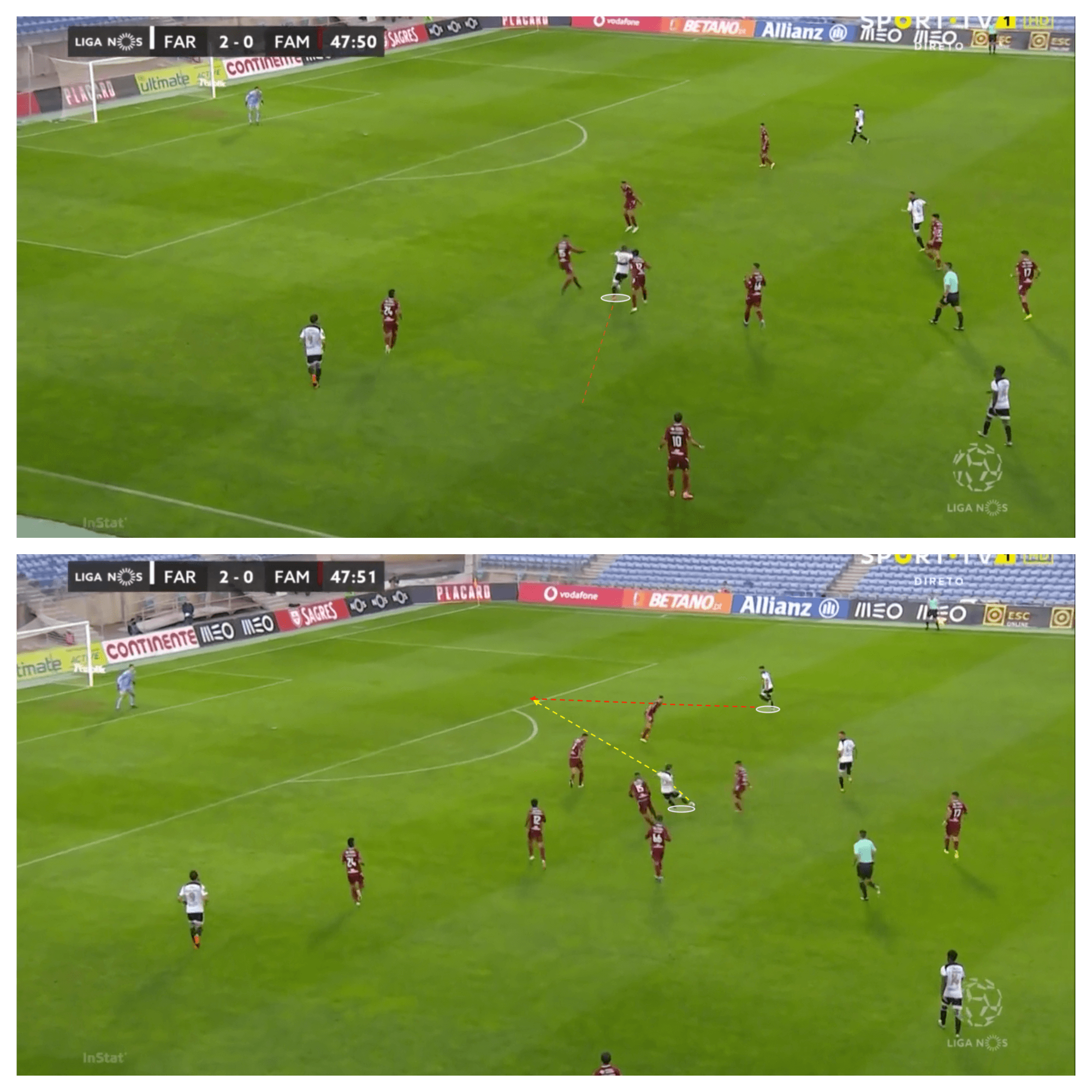
A different type of situation requires a different solution and Gauld is able to create danger from various positions and situation, when playing as a winger, Ryan Gauld’s role is to be a wide playmaker. This means that he is supposed not only to play passes to dangerous areas or combine with teammates in more central areas, but also to deliver good crosses or through passes into finishing positions. Crossing is one of the characteristics where Ryan Gauld stood out on the statistical analysis, more precisely, the Scottish ranked high for dangerous crosses per 90. Ryan Gauld is able to deliver very good crosses in behind the opposition’s defensive line both from open play and set pieces.
In the image below we can see Gauld delivering a great cross in behind the opposition’s defensive lien for a teammate to attack, again, the Scot makes full use of his technique and is able to deliver the ball into finishing positions with good speed, placement and timing.
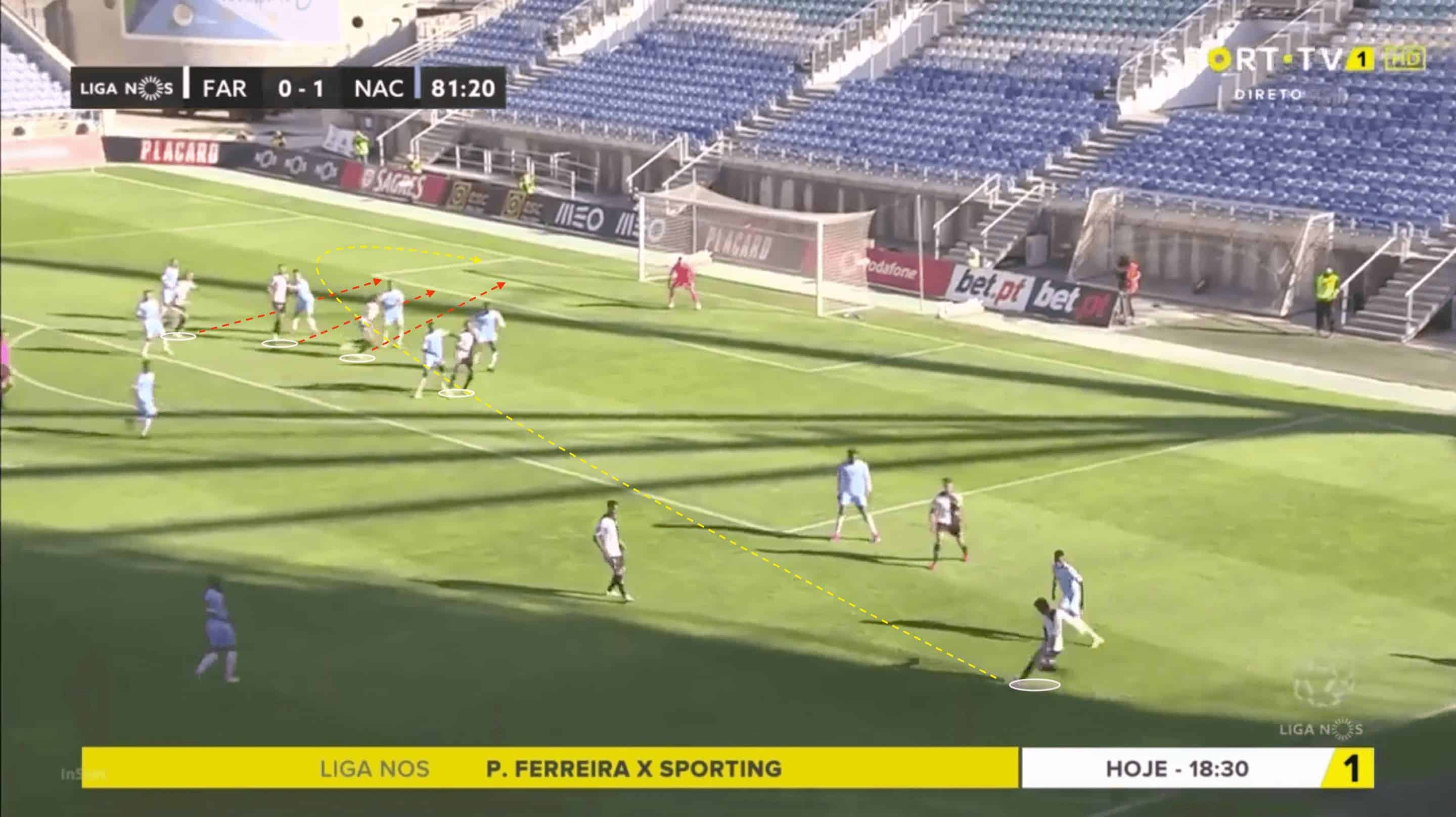
To complement our analysis on Gauld’s ability to create chances and get the ball into dangerous areas we are going to take a look at his penalty area deliveries map taken from Wyscout. This map shows the locations where the actions start and end allowing us to have a good picture of Gauld’s deliveries spatially and in regards to their nature as well.
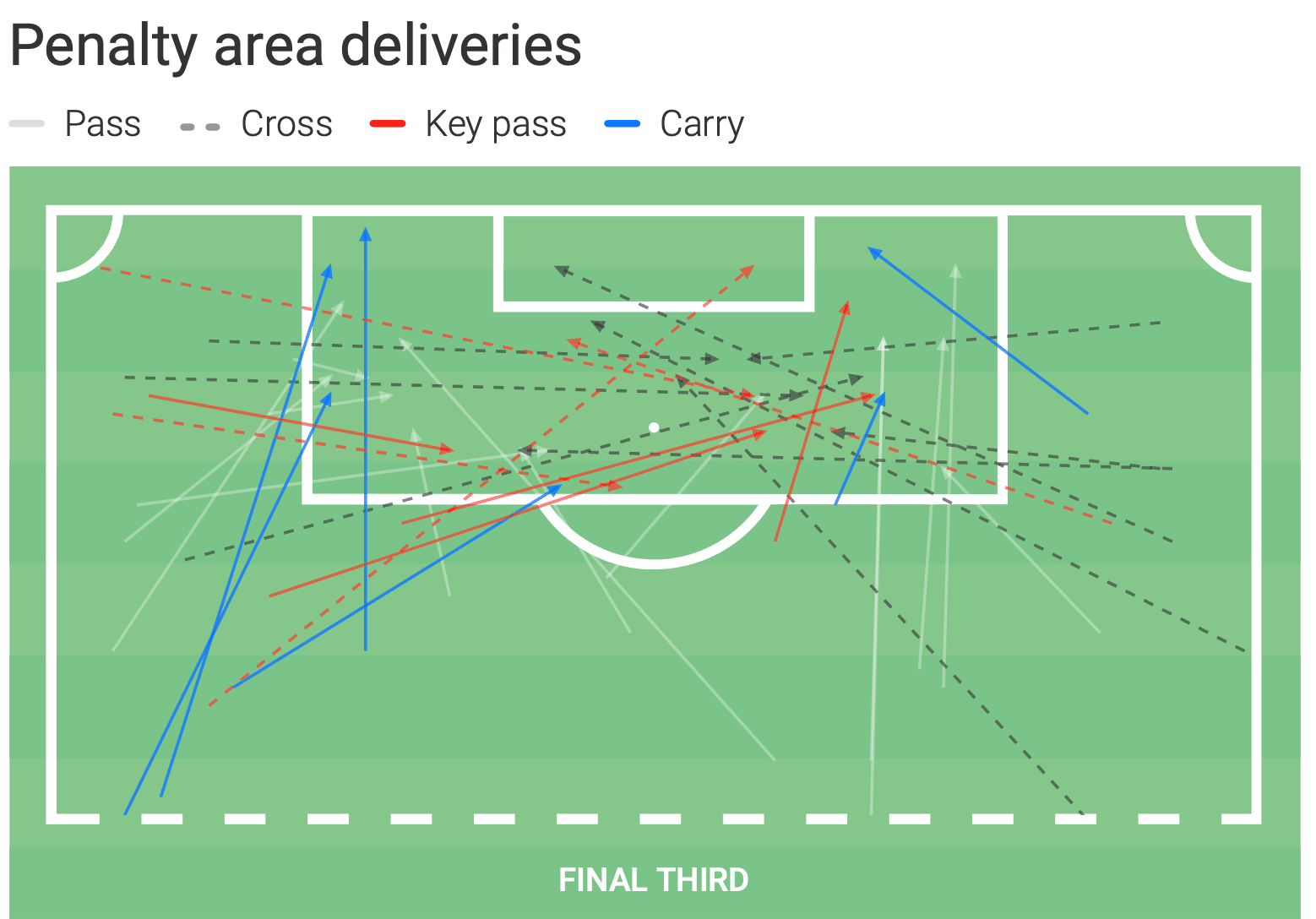
An analysis of the map shows us some already known patterns, much like with progressive actions, most of Ryan Gauld’s penalty area deliveries come from either the wide or half spaces. In terms of their nature, key passes and crosses are clearly the preferred way for Ryan Gauld to deliver the ball into the penalty area, nevertheless, the Scottish also registers with some ball carries into the area.
Goalscoring
Last but not least, we are going to take a look at Ryan Gauld’s goalscoring abilities. Although Gauld is primarily a chance creation player he is able to get into good scoring positions when he is not delivering the final pass or cross. Despite being very short at only 1.65m, Gauld often attacks the front post when crosses are played in and tries to get a head on goal. In fact, Gauld scored and assisted with this type of movement last season.
In the sequence of images below we can see Ryan Gauld performing the movement previously mentioned, he is aware of the intention of his teammate to cross and makes a run into the front post to get a header and score a great goal.
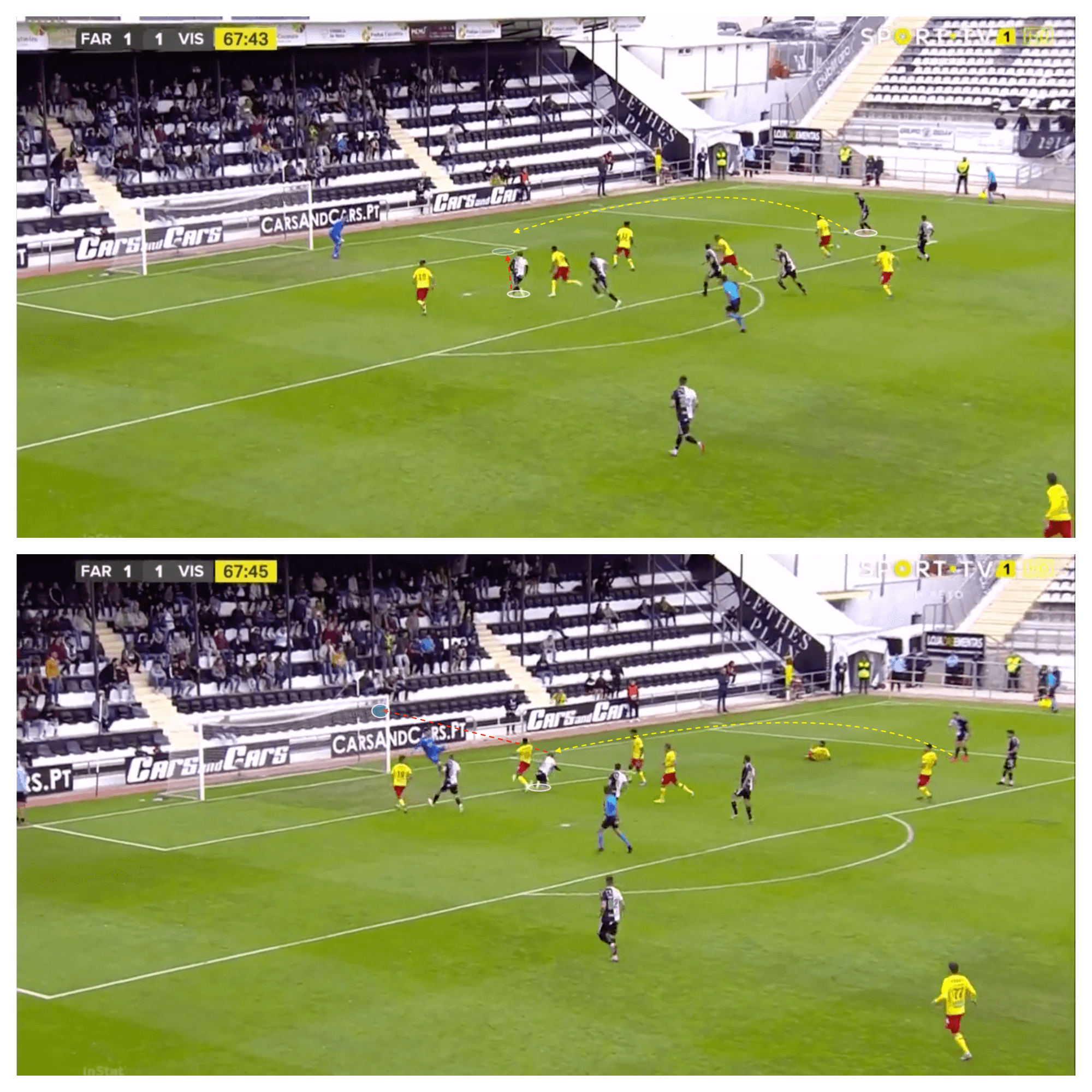
But Gauld’s most common finishing scenarios are not headers of course, most times Ryan Gauld gets into finishing positions around the penalty area or as a late runner waiting for a pullback. The Scottish international isn’t afraid to shoot from distance either, If he sees the opportunity, Gauld goes for the long shot and tries to score.
In the image below we can see one of the 24-year-old’s goals after receiving a pass near the edge of the penalty area. He sees the space left open by the defensive line due to his teammate’s run and falls back to receive the pass with a lot of space to place his shot and score.
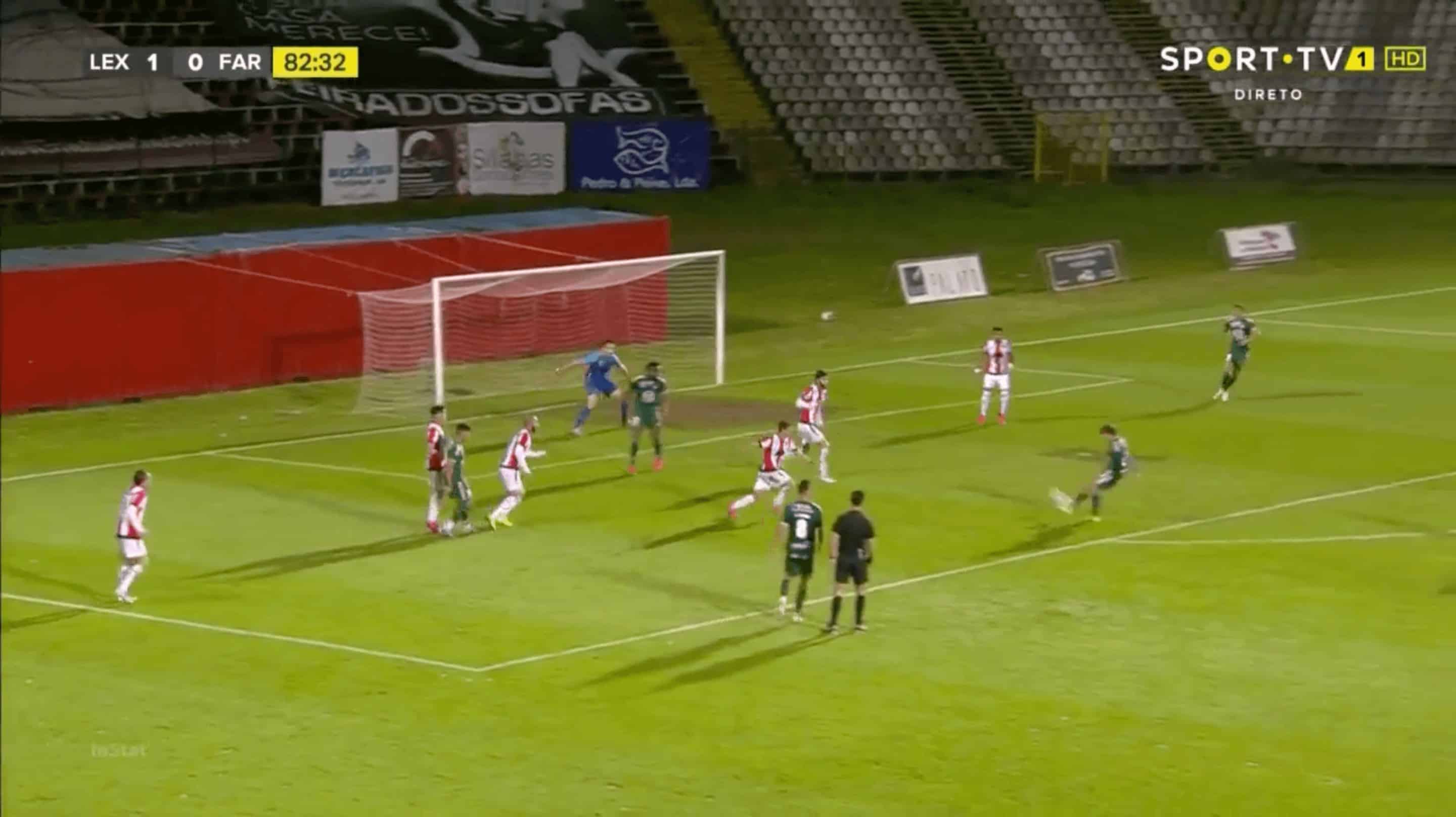
Finally, and to have a more general view of Ryan Gauld’s attempts at goal, we are going to take a look at his shot map taken from Wysocut. This map shows the locations from where shots were made and also classifies them according to their result.
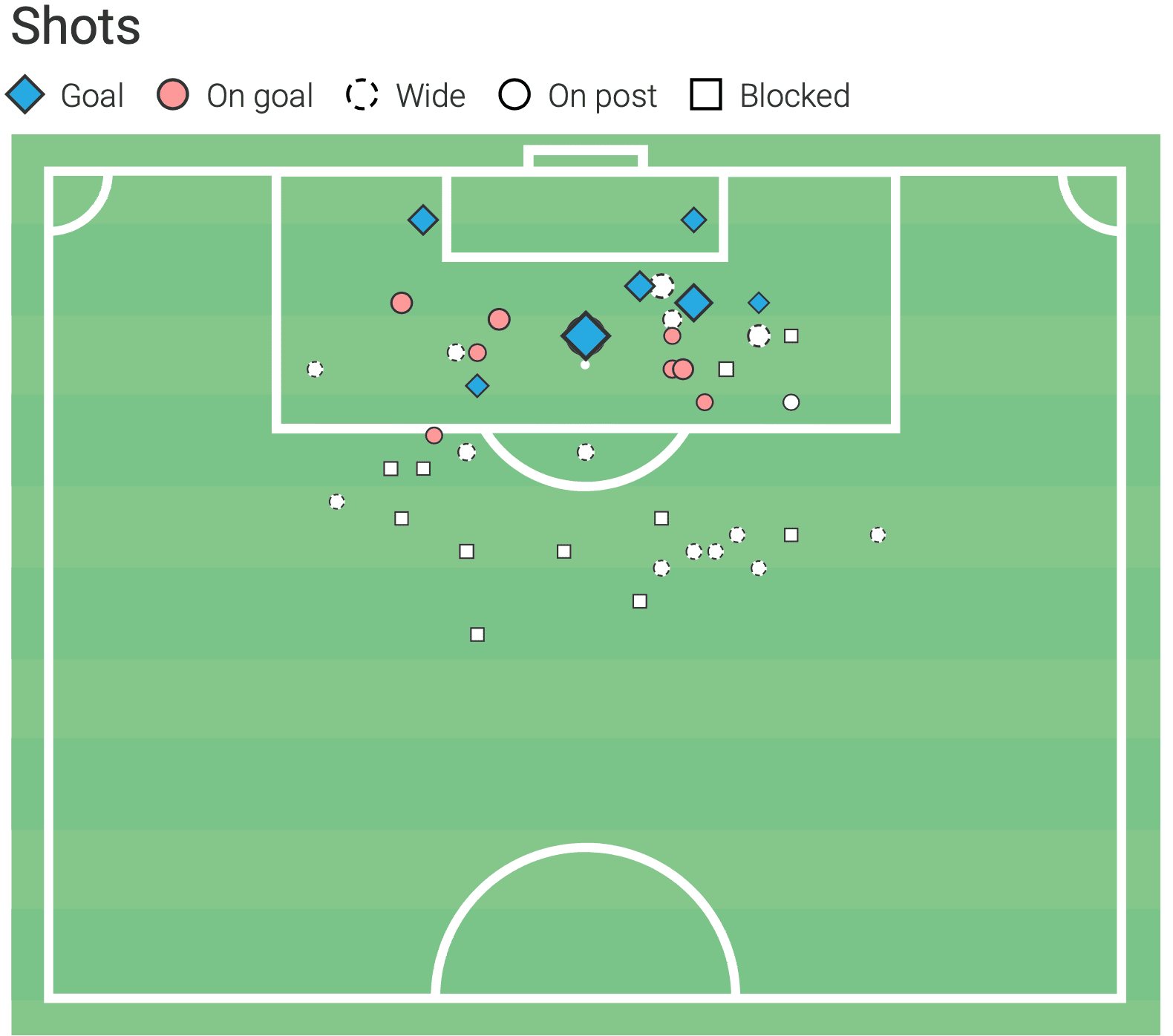
Conclusion
In this article we took a look at Ryan Gauld’s history and how expectations potentially had a bad impact in the beginning of his career when he went to Sporting CP at such a young age. After making his way through Sporting youth and B teams Gauld was not getting as much game time and wasn’t perhaps at the level fans and the coaches expected and was loaned out. Fast forward to recent times Gauld had an amazing 2019/2020 season at Farense and got promotion to the first division. The question rises again: Is this the year for Ryan Gauld in Portugal’s top tier?
We analysed his statistical profile from his season for Farense in 2019/2020 and saw how he stood out in most analysed metrics, we also analysed his in-game actions and style of play to understand what kind of player is Ryan Gauld after all this time. The verdict? Ryan Gauld seems to be in his best form and at 24 he might have the perfect opportunity to prove his value in the Portuguese top division if he is able to keep his form which he has done so far with 2 assists to show for it.

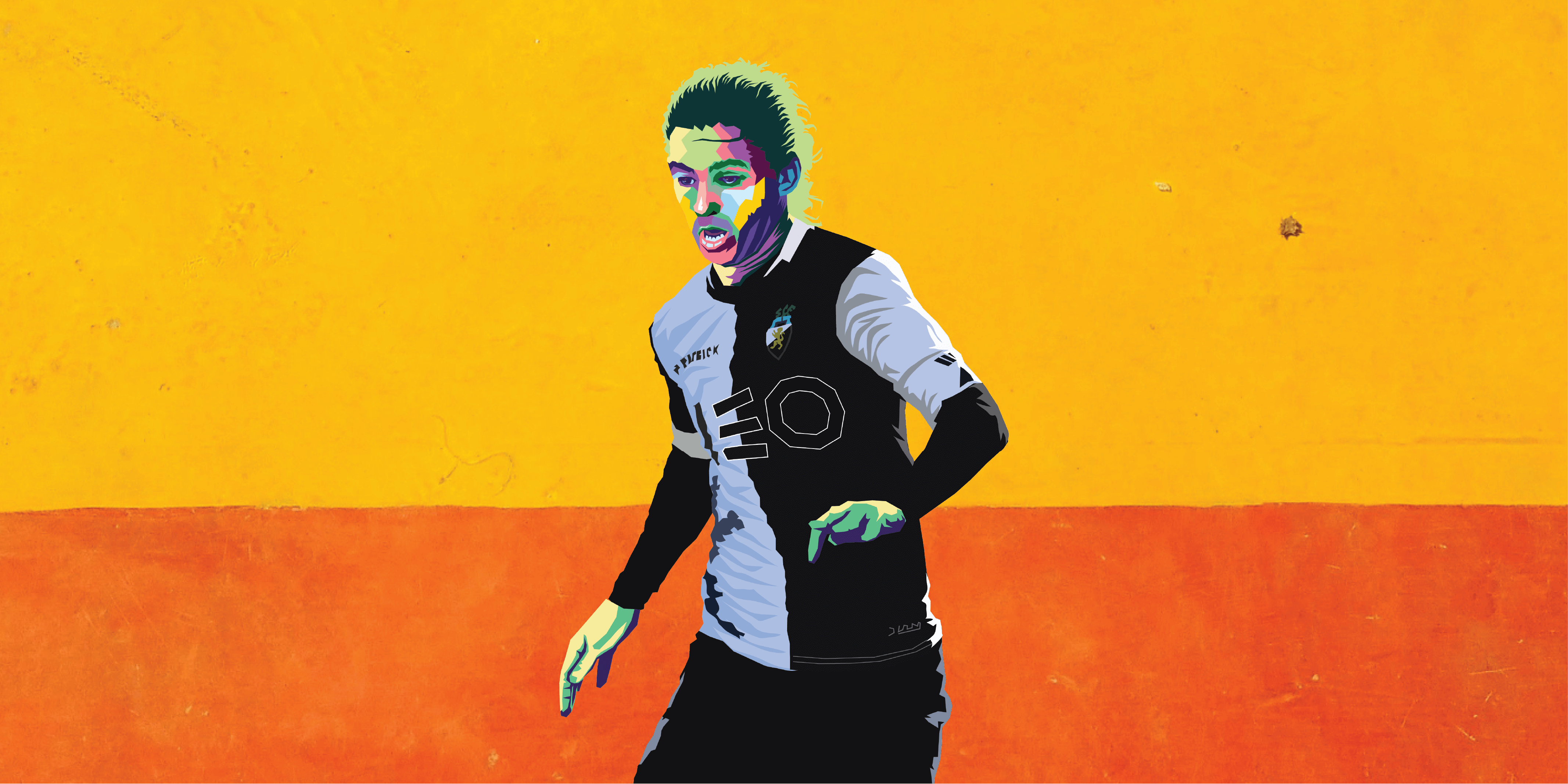




Comments